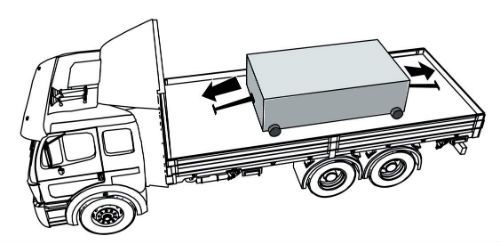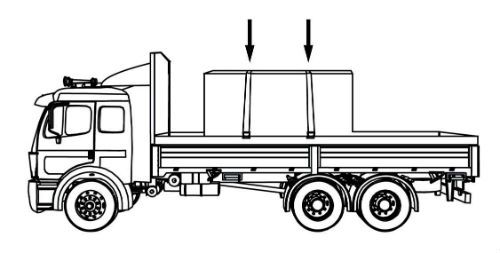CDL Practice Tests: Flatbed Cargo Securement
Choose A Section:
Go!What is bell pipe concrete?
- Pipe used to make concrete bells.
- Concrete used to make bell pipe.
- Pipe whose flanged end is of larger diameter than its barrel.
- Pipe whose flanged end is of smaller diameter than its barrel.
Bell Pipe Concrete:
Pipe whose flanged end is of larger diameter than its barrel.
High friction securement devices include:
- These can all be used for securement.
- Piece of wood with friction surface
- Cleated mat
- Friction mat
High Friction Devices
- Friction mat
- Piece of wood with friction surface
- Cleated mat
- Other specialized equipment
Load securement for cargo weighing 29,650 lbs must be able to withstand upward force of how many lbs?
- 30,000 lbs
- 5,930 lbs
- 14,825 lbs
- 29,650 lbs
How strong must the vehicle structure and anchor points be?
All elements of the vehicle structure and anchor points must be strong enough to withstand the forces described on page 7.
- Forward force: 0.8 g (80%)
- Rearward force: 0.5.g (50%)
- Sideways force: 0.5 g (50%)
- Upward force: 0.2 g (20%)
When calculating directional forces, 'g' is expressed as:
- The maximum load that may be applied to a component of a cargo securement system during normal service, usually assigned by the manufacturer of the component.
- The maximum load that may be applied to a component of a cargo securement system during normal service, usually assigned by the manufacturer of the component.
- The summation of the working load limits or restraining capacity of all devices used to secure an article on a vehicle.
- The acceleration due to gravity, 9.823 m/sec2 (32.2 ft/sec2). For cargo securement purposes it is expressed as a percentage of cargo weight, i.e. .5g is 50% of force of gravity or 50% of cargo weight.
g:
The acceleration due to gravity, 9.823 m/sec2 (32.2 ft/sec2). For cargo securement purposes it is expressed as a percentage of cargo weight, i.e. .5g is 50% of force of gravity or 50% of cargo weight.
What is the Aggregate WLL of the securement system for a load secured with 7 tiedowns: 3 rated at WLL of 4,000 lbs, 2 at 6,500, and 1 at 8,000?
- 8,250 lbs
- 16,500 lbs
- 10,000 lbs
- 33,000 lbs
How do you calculate Aggregate Working Load Limit for tiedowns?
To calculate Aggregate Working Load limit, add together:
- 50% of the WLL of each end section of a tiedown that is attached to an anchor point.
- 50% of the WLL of each end section that is attached to the cargo
In cargo securement, a wedge is defined as:
- A short piece of material, usually wood, nailed to the deck to reinforce blocking.
- A rail along the side of a vehicle that protects the side of the vehicle from impacts.
- A tapered piece of material, thick at one end and thin at the other, used to help keep cargo from moving.
- The depression formed between two cylindrical articles when they are laid with their eyes horizontal and parallel against each other.
Wedge:
A tapered piece of material, thick at one end and thin at the other, used to help keep cargo from moving.
To secure a cubic-shaped boulder, how many tiedowns are required, at minimum?
- 1
- 2
- 3
- 5
Special Circumstances: Securing a Cubic-Shaped Boulder
The securement of a cubic-shaped boulder must meet these requirements in addition to the other large boulder requirements in Section 13.

Secure each boulder individually with at least two chain tiedowns placed side-to-side across the vehicle.
Place tiedowns as closely as possible to the hardwood blocking used to support the boulder.
When securing rolls of paper with eyes vertical, how many points of contact are required to consider a roll secure?
- 3
- 4
- 2
- 1

Usually the roll is secure if a paper roll has 3 well-separated points of contact with the vehicle, other rolls, or other cargo.
When securing an intermodal container on a chassis, what is the maximum allowable vertical travel when secured?
- 2 inches
- 2 1/2 inches
- 1 inch
- 1/2 inch
Securing devices must restrain the container from moving more than:
- 1.27 cm (1/2 in) forward.
- 1.27 cm (1/2 in) rearward.
- 1.27 cm (1/2 in) to the right.
- 1.27 cm (1/2 in) to the left.
- 2.54 cm (1 in) vertically.
When banding paper rolls with eyes vertical, you should:
- Apply bands loosely.
- Spread rolls apart from each other.
- All of these are necessary.
- Secure bands with tape, hangers, or other means.
Banding
If paper rolls are banded together:

- Place rolls tightly against each other to form a stable group.
- Apply bands tightly.
- Secure bands with tape, hangers, or other means so that the bands cannot fall off the rolls or slide down to the deck.
About The Flatbed Cargo Securement CDL Manual
Studying the flatbed cargo securement CDL manual is not a requirement for getting your CDL permit or license. It is required knowledge for flatbed drivers.
Some questions you should be able to answer for flatbed cargo securement:
- What is the minimum Working Load Limit of a tiedown used to secure logs?
- What is the minimum weight of a shipment of paper rolls that would require specific securement requirements?
- When securing concrete pipe over 45 inches loaded crosswise, which direction must the tiedowns on the front half of the load run?
- What is a cab shield?
- When securing concrete pipe over 45 inches loaded crosswise, which direction must the tiedowns on the rear half of the load run?
- What is a dunnage bag?
- Who is responsible for inspecting securing devices and cargo within the first 50 miles?
- How many tiedowns are required on a stack of shortwood loaded crosswise?
- What is the minimum working load limit of each tiedown used to secure crushed or flattened vehicles?
- Define 'bolster'
- What is a hook-lift container?
- When a tiedown is attached directly to the cargo, what is the ideal angle where it attached to the vehicle?
What is a securing device?
Any device specifically manufactured to attach or secure cargo to a vehicle or trailer:
- Synthetic Webbing
- Chain
- Wire rope
- Manila rope
- Synthetic rope
- Steel strapping
- Clamps and latches
- Blocking
- Front-end structure
- Grab hooks
- Binders
- Shackles
- Winches
- Stake pockets
- D-rings
- Webbing ratchet
- Bracing
- Friction mat
What is a tiedown?
A combination of securing devices that forms an assembly that:
- Attaches cargo to, or restrains cargo on a vehicle.
- Is attached to anchor point(s).

Some tiedowns are attached to the cargo and provide direct resistance to restrain the cargo from movement.

Some tie-downs pass over or through the cargo. They create a downward force that increases the effect of friction between the cargo and the deck. This friction restrains the cargo.
 Related Cargo Securement Terms That Every Driver Should Know:
Related Cargo Securement Terms That Every Driver Should Know:
-
Tiedown:
A combination of securing devices which form an assembly that attaches cargo to, or restrains cargo on, a vehicle or trailer, and is attached to anchor point(s).
-
Contained:
Cargo is contained if it fills a sided vehicle, and every article is in contact with or sufficiently close to a wall or other articles so that it cannot shift or tip if those other articles are also unable to shift or tip.
-
Blocking:
A structure, device, or another substantial article placed against or around an article to prevent horizontal movement of the article.
How should tiedowns be attached?
Tiedowns can be used in two ways:
-
Attached to the cargo:
- Tiedowns attached to the vehicle and attached to the cargo.
- Tiedowns attached to the vehicle, pass through or aroundan article of cargo, and then are attached to the vehicle again.
-
Pass over the cargo:
- Tiedowns attached to the vehicle, passed over the cargo, and then attached to the vehicle again.
Tiedown placement:

Place the tiedown as close as possible to the spacer.
Position the tiedowns as symetrically as possible over the length of the article.

Position the tiedowns to preserve the integrity of the article.







 TT On Facebook
TT On Facebook